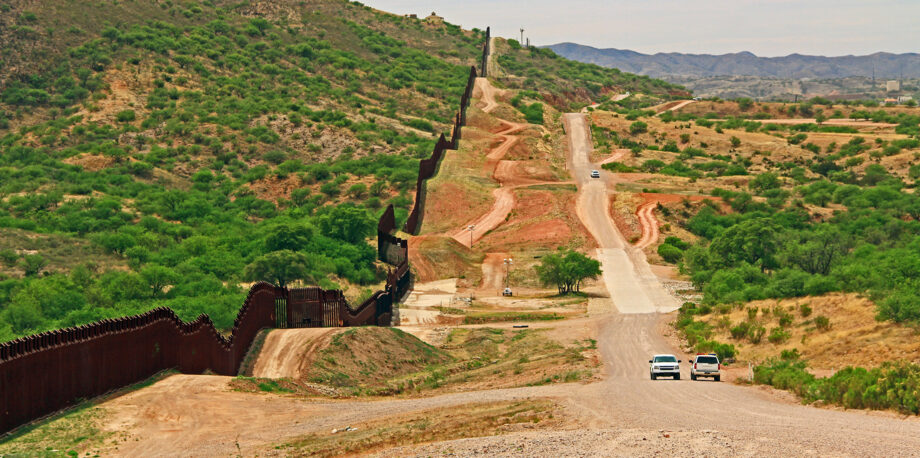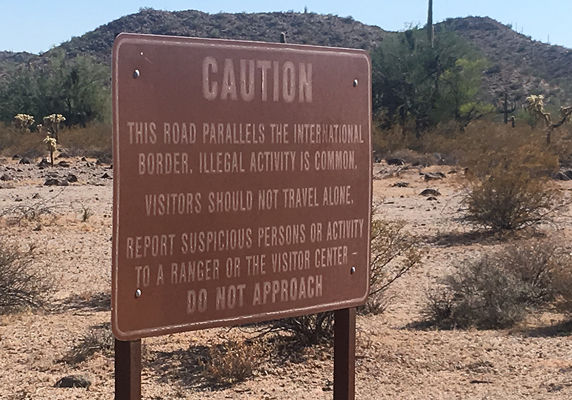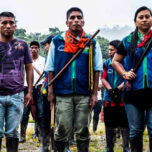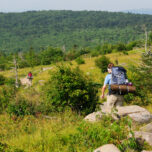January 31, 2020 — Editor’s note: Most of Ensia’s content is available under Creative Commons; this story is excluded.
The stretch of Highway 2 in northern Mexico from San Luis Río Colorado to Sonoyta passes through seemingly otherworldly terrain: a UNESCO-protected area within the Sonoran Desert, one of the most biologically diverse places in the world. More than 2,000 species of plants grow here, among dormant volcanos and sand dunes, along with more than 350 species of birds, dozens of mammals and reptiles, and freshwater fish. It’s 120,000 square miles (311,000 square kilometers) of desert — one of the four great deserts of North America — a vast ecosystem with little regard for the nations it spans or the politics that govern them.
The Sonoran ecosystem is just one of the many such landscapes that cross the U.S.–Mexico border, often protected by an at-times overlapping tapestry of federal agencies, conservation organizations and indigenous tribes. The 1,750 square miles (4,500 square kilometers) of the Tijuana River Watershed cross from Baja California to California. At around 200,000 square miles (518,000 square kilometers), the Chihuahuan Desert reaches from central Mexico north to New Mexico. The Rio Grande watershed stretches from Colorado across Texas, where it forms a natural boundary between the U.S. and Mexico before draining into the Gulf of Mexico.
For decades, scientists, activists, government employees and academics crisscrossed these areas regularly, meeting their peers in the field for data collection, to attend or present at conferences, to learn from their colleagues across the border. But while concerns about safety and decreases in funding for research have been growing issues on both sides of the border for years, the immigration policies of the current U.S. administration have led to a near shutdown of scientific and governmental collaboration in these critical areas.
“There were a lot of days we would cross the border every single day,” says Laiken Jordahl, a former wilderness fellow at Organ Pipe National Monument in Arizona, a border park that often features prominently in border debates. “So easy to get through at that [Sonoyta] crossing, so low key. We could leave our offices, cross the border, have lunch, come back within 45 minutes.” Jordahl, who also served as a wilderness fellow at Big Bend National Park, now works with the Center for Biological Diversity, tracking the environmental impact of the U.S. administration’s border wall construction in fragile borderlands. These days, whenever he crosses the border, Jordahl says he and his colleagues are stopped for extended questioning by U.S. Border Patrol officials.
VIDEO: #BorderWall construction is imminent through Arizona’s spectacular San Pedro River.
Dozens of cottonwoods are flagged for removal. Border Patrol says they will break ground in next 2 weeks.
Everyone should see this sacred place before it’s too late… pic.twitter.com/FGnqDN5MjP
— Laiken Jordahl (@LaikenJordahl) December 20, 2019
“I think it goes without saying that … the rhetoric from the current administration does grievous harm to any collaboration, to any big-picture dreaming about collaborative ideas,” Jordahl says. “I mean, we’re not even in the same universe as being able to talk about some of those ideas as we used to be.”
Shuttered and Shelved
Many Americans may know pieces of these ecosystems, long protected as national parks, wildlife refuges, scenic rivers, forests, estuaries and more. Within them are Organ Pipe Cactus National Monument, Big Bend National Park, El Pinacate y Gran Desierto de Altar Sonora, Buenos Aires National Wildlife Refuge, Coronado National Memorial, the Rio Grande Wild & Scenic River, Amistad National Recreation Area, and dozens of other iconic and lesser-known sites protected by the National Park Service*, the U.S. Forest Service, the Bureau of Land Management, the U.S. Fish and Wildlife Service, the U.S. military, and others.
These borderlands encompass some of the most diverse, fragile, once-contiguous landscapes in the world, and were long seen as the joint responsibility of both Mexican and American governments. However, the current political climate has had a chilling effect on cross-border research and collaboration critical to understanding, and protecting, these increasingly fragmented areas.
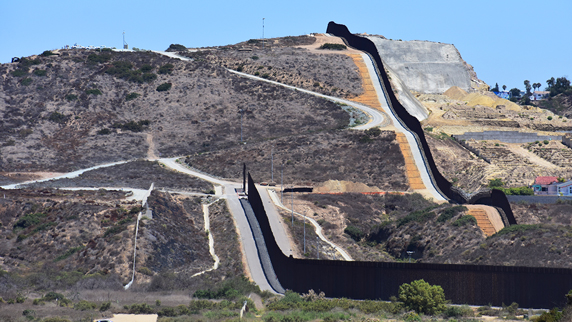
The beginning of the border wall marks the edge of the U.S. boundary of the Tijuana River National Estuarine Research Reserve. Photo by Molly McCluskey
A number of federal initiatives designed to protect borderland ecosystems have been shuttered or shelved or had funding reduced in the past several years. Some have been outright defunded, like the Southwest Border Resource Protection Program, which was designed to foster collaboration and cultural and resource protection in the borderlands, but in later years under the Obama administration was more likely to fund law enforcement, according to Jonathan Jarvis, the former director of the National Park Service under President Obama. Those funds have now been shifted to a larger departmental budget under the Office of International Affairs within the National Park Service. Meanwhile, employees at environmental nonprofit organizations report that a number of other, longstanding grants from the National Park Service, the U.S. Forest Service and other U.S. governmental organizations are no longer available or were delayed indefinitely.
“We’ve had grants awarded successfully [in the past],” says Louise Misztal, executive director of the Sky Island Alliance, which works on cross-border resource protection “But [now] all grant applications suddenly have to go through a national review process with a third party, which slows things down considerably to the point where I think they’re just not awarded at all.”
Other programs, including a vision of the U.S. Environmental Protection Agency (EPA) called Border 2020, have goals that seem inconceivable now, including a reduction in air pollution, lower vehicle emissions and climate action plans. The North American Committee on Cooperation for Wilderness and Protected Areas Conservation (NAWPA), a coalition of some of the largest land management agencies in Canada, the U.S. and Mexico, was established in 2009 with the intention of holding an annual conference. The last conference was held in Yukon, Canada, in 2017 — in part, multiple people who had previously attended say, because of the difficulty in securing international travel permissions from their employers and the visas necessary to cross the borders. All of this has made field research, which was previously routine — and almost mundane — nearly impossible.
“The people we worked with at the Department of the Interior, the Fish and Wildlife Service, the National Park Service, all said that their agencies banned travel to Mexico,” Misztal says. Particularly frustrating for Misztal was that her colleagues in Mexico suddenly had difficulty getting visas to meet, attend conferences or conduct research in the U.S.
Decline in Collaboration
It’s not only government agencies that are feeling the brunt. The Nature Conservancy’s (TNC’s) Lennox Foundation Southmost Preserve in Texas is split in two, with more than 800 of its 1,014 acres (324 of its 410 hectares) south of the border wall, heavily patrolled by the Border Patrol, and difficult to access by the organization’s field staff, visiting researchers and school groups. The organization, which has a house in the fenced area, previously had staff on-site around the clock for wildlife and habitat monitoring, and could welcome researchers for extended stays. That’s now impossible, say some people familiar with the site.
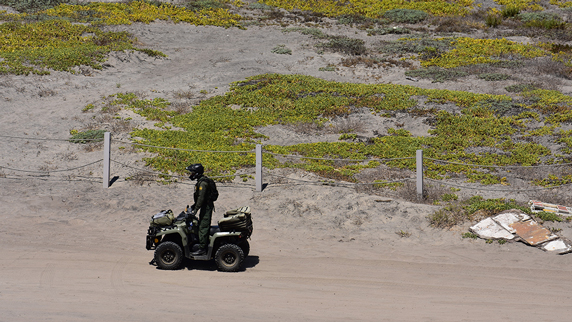
A Border Patrol agent rides an ATV through Tijuana River National Estuarine Research Reserve. Photo by Molly McCluskey
“This property is so special, and the Rio Grande Valley overall is one of the most special places in the U.S.,” says Sonia Najera, The Nature Conservancy Texas’ grasslands program manager. “But it’s not easy to just roam around and conduct research. The property is very easy to get lost in. Lots of trails, strips of grasses, the river winds and turns, and the terrain changes.” Guests and visitors have to be monitored at all times by both TNC and Border Patrol personnel, something that can hinder, and be hindered by, other Border Patrol activities.
Ben Lomeli was a hydrologist with the U.S. Bureau of Land Management in Arizona, working on issues affecting the San Pedro Riparian National Conservation Area, on and off since 1988. The San Pedro River is one of the last undammed large rivers in the U.S. Southwest and one of only two large rivers that flow north into the U.S. from Mexico. Lomeli says he has seen a decline in collaboration between the two countries for years, and that it goes beyond any one administration. However, he says the quickening pace of it in the past two years, and what he felt was pressure from his supervisors to sign off on questionable practices, led him to take an early retirement in June 2017, a decision that he says he felt forced into making.

Forty miles of the San Pedro River run through the San Pedro Riparian National Conservation Area, creating an ecosystem that dozens of mammals, birds, amphibians and reptiles call home, as well as an important resource for migrating birds. Photo courtesy of BLM from Flickr, licensed under CC BY 2.0
“As far as the science goes, we started seeing some agencies pulling back on international coordination for studies and scientific investigations. We had a lot of interactions going on along the Nogales, Arizona–Sonora border, and we’ve pulled those back,” Lomeli says.
Other Ways Forward
While it would be easy to become disheartened by the obstacles, these borderland caretakers are keeping their eye on the bigger landscape: the ecosystems that will outlast any one administration or era. Many are finding creative ways to work around government hurdles and contribute to the land they’ve spent their careers tending. Lomeli volunteers with local parks and environmental nonprofit organizations in his beloved San Pedro River area. Jordahl closely monitors the building of the border wall and its environmental destruction, sharing his findings on his social media accounts and using them to further the work of the Center for Biological Diversity.
Jarvis is now the executive director of the Institute for Parks, People, and Biodiversity at the University of California, Berkeley, helping countries like Chile establish a national parks system based on the U.S. model. He believes in the inherent power of scientific collaboration as a critical foreign policy tool, and is forging ahead, regardless of the obstacles.
“We have to continue to work these areas of soft diplomacy across borders if we’re going to preserve biodiversity,” he says.
Related Posts
Ensia shares solutions-focused stories free of charge through our online magazine and partner media. That means audiences around the world have ready access to stories that can — and do — help them shape a better future. If you value our work, please show your support today.
Yes, I'll support Ensia!